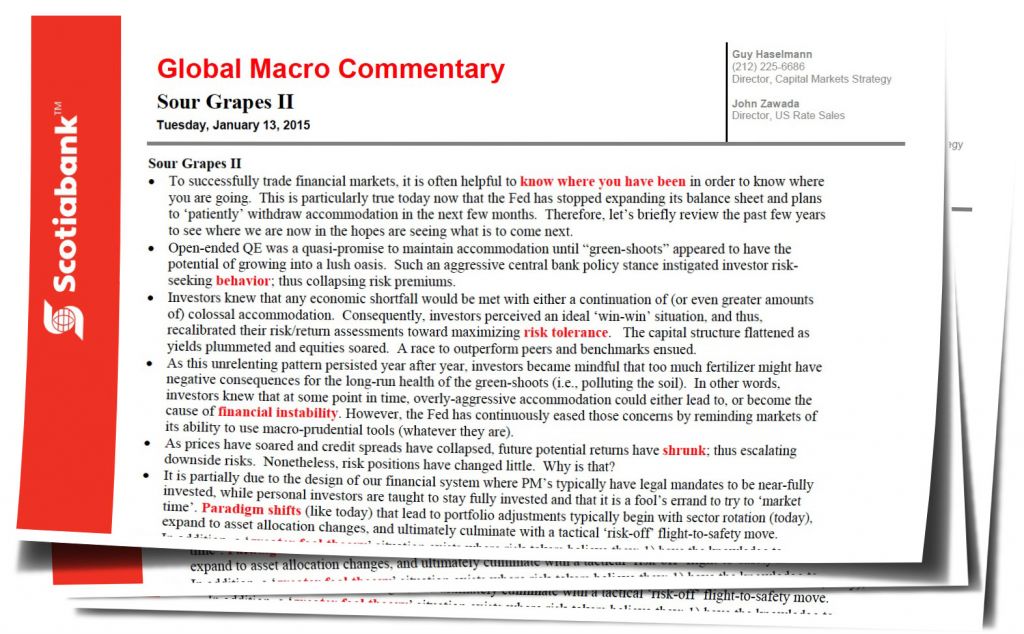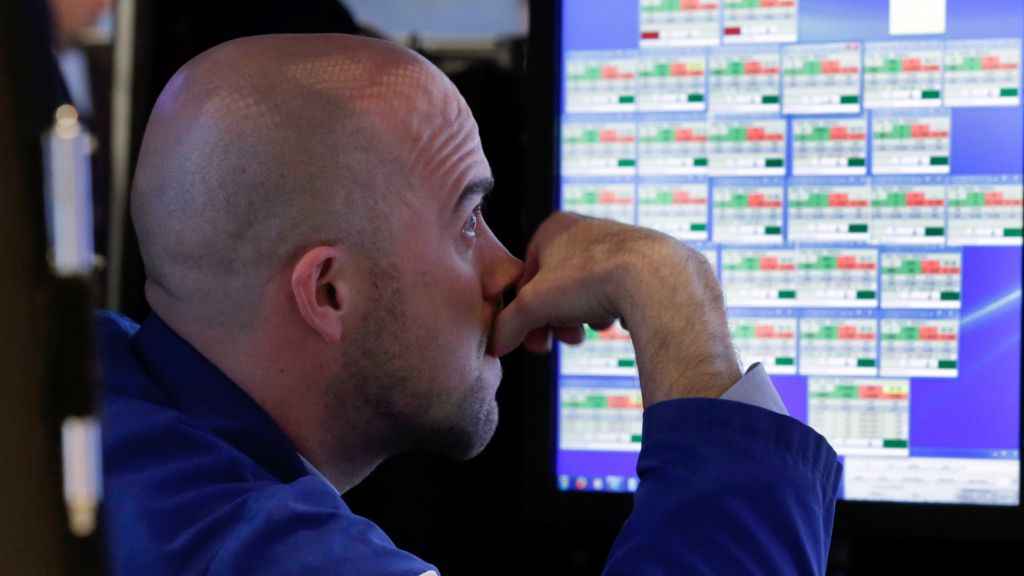Sour Grapes II
by Guy Haselmann, Director, Capital Markets Strategy, Scotiabank GBM
· To successfully trade financial markets, it is often helpful to know where you have been in order to know where you are going. This is particularly true today now that the Fed has stopped expanding its balance sheet and plans to ‘patiently’ withdraw accommodation in the next few months. Therefore, let’s briefly review the past few years to see where we are now in the hopes are seeing what is to come next.
· Open-ended QE was a quasi-promise to maintain accommodation until “green-shoots” appeared to have the potential of growing into a lush oasis. Such an aggressive central bank policy stance instigated investor risk-seeking behavior; thus collapsing risk premiums.
· Investors knew that any economic shortfall would be met with either a continuation of (or even greater amounts of) colossal accommodation. Consequently, investors perceived an ideal ‘win-win’ situation, and thus, recalibrated their risk/return assessments toward maximizing risk tolerance. The capital structure flattened as yields plummeted and equities soared. A race to outperform peers and benchmarks ensued.
· As this unrelenting pattern persisted year after year, investors became mindful that too much fertilizer might have negative consequences for the long-run health of the green-shoots (i.e., polluting the soil). In other words, investors knew that at some point in time, overly-aggressive accommodation could either lead to, or become the cause of financial instability. However, the Fed has continuously eased those concerns by reminding markets of its ability to use macro-prudential tools (whatever they are).
· As prices have soared and credit spreads have collapsed, future potential returns have shrunk; thus escalating downside risks. Nonetheless, risk positions have changed little. Why is that?
· It is partially due to the design of our financial system where PM’s typically have legal mandates to be near-fully invested, while personal investors are taught to stay fully invested and that it is a fool’s errand to try to ‘market time’. Paradigm shifts (like today) that lead to portfolio adjustments typically begin with sector rotation (today), expand to asset allocation changes, and ultimately culminate with a tactical ‘risk-off’ flight-to-safety move.
· In addition, a ‘greater fool theory’ situation exists where risk-takers believe they: 1) have the knowledge to recognize the opportune time when to pare risk; 2) are able to identify the key catalysts that will derail the ‘upside’, and ; 3) will have sufficient market depth and liquidity to exit exposures without much slippage.
· However, since the Fed’s balance sheet has stopped rising and FOMC members are warning that official rates are likely to rise soon for the first time in nine years, isn’t maintaining a ‘risk-seeking’ predisposition imprudent behavior and ‘yesterday’s trade’? Since the Fed’s policy pivot has shifted the upside/downside distribution of market risk to a materially worse risk vs. reward tradeoff, shouldn’t exposures be adjusted accordingly?
· There are some factors based in behavioral psychology that may explain the slow response. Last January, I wrote a note (Sour Grapes 1/28/14) that discussed ‘cognitive dissonance’: a psychological term and state that exists any time a person holds two conflicting beliefs, values, or emotional responses. Recent (today’s) wild market volatility may be exposing the conflict between investment positions and shifting beliefs.
· Since investors are both structurally and voluntarily positioned for equity market upside, they yearn to ‘hear’ a supporting story to eliminate their inherent conflict. As the Fed attempts to lessen accommodation, FOMC messages emphasize ‘patience’, due to Fed fears of disrupting the financial market ‘apple cart’. Such soothing words falsely pacify investors. Some investors might even be lulled into believing that the Fed will be so patient as to not hike at all in 2015. This interpretation and other shaky justifications are made to ease the discomfort brought about by the incongruous situation of investor cognitive dissonance.
· John Hussman wrote an outstanding paper on January 12th entitled, “A Better Lesson Than This Time is Different”. It can be found on the Hussman Funds website. In it, he tried to identify and classify market return/risk profiles. He characterizes current equity markets as over-valued, over-bought, and overly-bullish. He attempts to find distinctions between over-valued markets that become more over-valued, and those that are vulnerable to a crash. Hussman believes the breakdown of market internals combined with inadequate risk premiums have made the equity market vulnerable to abrupt and severe market losses.
· In order to justify general equity market over-weights, either risk premiums needs to fall further, or the economy and financial markets need to have reached a level of ‘escape velocity’ powerful enough to push them forward, even in the face of Fed rate hikes. I find such a ‘soft landing’ scenario improbable at best.
Market Comment
· I am concerned that a sizable equity market correction looms. Treasuries would benefit from such, but believe they will continue to trade extraordinarily well nonetheless for several reasons: 1) strong USD and yield pick-up makes them attractive to foreigners; 2) Fed is hoarding them (own 45% of all 10yrs and longer); 3) Regulatory rules have increased demand from dealership community; 4) Pension rule changes incentivize LDI; 5) US fiscal deficit is shrinking, and; 6) Strengthening USD is disinflationary. [Note: While I remain a bond bull (back end), tactically, I would turn longs into a flattener just prior to the Jan. FOMC meeting which I expect to be hawkish.]
· “It is a happy faculty of the mind to slough that which conscience refuses to assimilate.” –William Faulkner
Regards,
Guy
Guy Haselmann | Director, Capital Markets Strategy
▬▬▬▬▬▬▬▬▬▬▬▬▬▬▬▬▬▬▬▬▬▬▬▬▬▬
Scotiabank | Global Banking and Markets
250 Vesey Street | New York, NY 10281
T-212.225.6686 | C-917-325-5816
guy.haselmann[at]scotiabank.com
Scotiabank is a business name used by The Bank of Nova Scotia
Copyright © Scotiabank GBM
Read/Download Guy Haselmann's complete report below:















